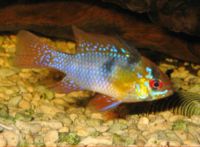Ram Cichlid (Mikrogeophagus ramirezi)
From The Aquarium Wiki
(Redirected from Ram Cichlid)
Ram Cichlid
Mikrogeophagus ramirezi
57 Litres (15 US G.)
3.8-5.1cm (1.5-2 ")
Freshwater
5.5 - 7.5
23.9-27.8°C (75 -82 °F)
5-12 °d
1:1 M:F
3-4 years
Family
Cichlidae
This animal is available captive bred
Contents
Additional names
- German Blue Ram, Balloon Ram, Butterfly Cichlid, Golden Ram, Singapore Ram, Blue Ram, Ram Cichlid
Additional scientific names
- Apistogramma ramirezi, Papilochromis ramirezi, Microgeophagus ramirezi
Sexing[edit]
- The male's front dorsal fin rays are much longer than the female's, forming a "spike." The dorsal fin of the male also tends to have a pointed shape near the caudal fin, where the female's is more rounded. Females are smaller and have a reddish tinge on their pelvic regions, especially when getting ready to spawn. Also, the black spot on the side of the female blue ram may have iridescent blue spangles throughout, and the male's tends to be solid black.
Breeding[edit]
- See our article on Breeding Mikrogeophagus ramirezi.
Tank compatibility[edit]
- Will generally work in peaceful community tanks with fast-moving fish or with other semi-aggressive South American Cichlids such as Angelfish, however, they should be observed carefully as some individuals can be more feisty than others and have been known to turn against tank mates possibly with fatal consequences.
Diet[edit]
- Feed a variety of foods, including a good flake or pellet as a staple and the occasional fresh or frozen treat.
Environment specifics[edit]
- A planted tank with dense foliage is preferred; however, artificial plants are also good. Rocks, such as slate or other elongated structures, are also recommended. Keep ammonia and nitrite at 0, nitrates must be below 10 ppm.
Behaviour[edit]
- Very shy. Can become territorial during breeding. Will occasionally display typical "cichlid" behaviour and go against their shy docile reputation, observe carefully.
Identification[edit]
- A highly attractive and popular dwarf cichlid. Predominantly blue, with yellow and orange hues, mostly orange around the head and the through the fins, and a large black spot on either side of the flanks.
Acclimation[edit]
- It is highly recommended that a quarantine tank be used for any new German Blue Ram additions. This will allow you to monitor their health. Two weeks is generally considered the minimum quarantine period.
- German Blue Rams are extremely sensitive to water parameters and are easily stressed. They are also prone to "premature" deaths due to breeding techniques utilized in Asia (more on that below).
- As a result, acclimation must be done with patience. Acclimation should not be rushed and should be performed for at least 45 minutes to an hour. Float the bag to equalize the temperature. Then add tank water slowly.
- Let the water run down the sides of the bag as splashing has been identified as stressful to them. Turn off tank lights prior to introduction to main tank. This allows your new German Blue Rams to become adjusted to their surroundings and deters other fish from becoming "nosey" and causing additional stress to them.
Additional Comments[edit]
- The German Blue Ram, although a very exciting and colourful fish, has created some discomfort for aquarists. Many aquarists have complained of premature demises of this wonderful fish, most often within a few days or within months after introducing them to their tank, despite being purchased from a very clean and reputable LFS.
- Researching this fish has revealed that most of the German Blue Rams available commercially are imported from Asia, where the fish are injected with hormones. This process results in the fish becoming more colourful and induces premature spawning. It is often recommended that aquarists obtain wild caught or spawns from breeders.
- A "balloon" variant of this fish is being sighted more frequently on the market. It is a man made enhanced genetic deformity characteristic made through selective breeding. It is believed that these fish have much shorter life spans[1] and are more prone to swim bladder and digestive disorders due to the unbalanced shape, they will also be bullied by regular German Blue Rams. Extra care is required to look after them.
- An "Electric Blue" variant is also becoming more common on the market. It is a much more vivid blue across the whole body from nose to caudal peduncle and lacks the black spot.
Pictures[edit]
Videos[edit]
| Ram fighting | Rams Spawning: | Electric Blue Rams: |
References[edit]
- ↑ Citation required!
Links[edit]
- Fishbase (Mirrors:
 )
)



